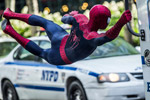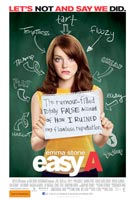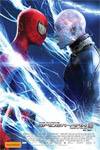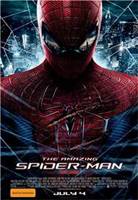Michael Keaton Birdman
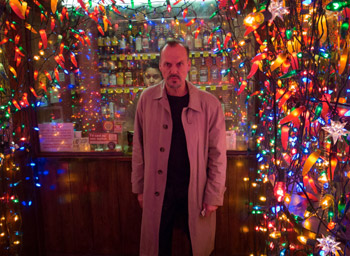
Michael Keaton Birdman
Cast: Michael Keaton, Zach Galifianakis , Edward Norton, Andrea Riseborough, Amy Ryan, Emma Stone, Naomi Watts, Lindsay Duncan, Merritt Wever, Jeremy Shamos, Bill Camp, Damian Young
Director: Alejandro Gonzlez Inarritu
Rated: R
Running Time: 119 minutes
Synopsis: Birdman or The Unexpected Virtue of Ignorance is a black comedy that tells the story of an actor (Michael Keaton) – famous for portraying an iconic superhero – as he struggles to mount a Broadway play. In the days leading up to opening night, he battles his ego and attempts to recover his family, his career, and himself.
Birdman
Release Date: January 15th, 2015
About The Production
'Destiny guides our fortunes more favorably than we could have expected."
- Don Quixote, by Miguel de Cervantes
In Birdman, Alejandro G. Iñárritu's black comedy, Riggan Thomson (Michael Keaton) hopes that by spearheading an ambitious new Broadway play he will, among other things, revive his moribund career. In many ways, it is a deeply foolhardy move – but the former cinema superhero has high hopes that this creative gambit will legitimise him as an artist and prove to everyone – and himself – that he is not just a Hollywood has-been. 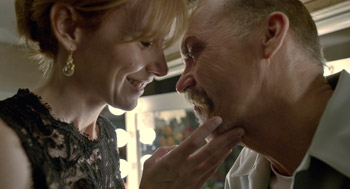
With the play's opening night looming, Riggan's lead actor is injured by a freak accident during rehearsals and needs to be replaced quickly. At the suggestion of lead actress Lesley (Naomi Watts) and the urging of his best friend and producer Jake (Zach Galifianakis), Riggan reluctantly hires Mike Shiner (Edward Norton) – a loose cannon who is guaranteed to sell tickets and get the play a rave review. As he preps for the stage debut, he must deal with his girlfriend and co-star Laura (Andrea Riseborough), his fresh-from-rehab daughter and personal assistant Sam (Emma Stone), as well as his ex-wife Sylvia (Amy Ryan), who appears every so often to check-in with the intent to stabilize things.
Alejandro G. Iñárritu notes that elements of Riggan's story resonated with him, particularly the ephemeral nature of success and the question of relevance. 'I was interested in exploring the battles with the ego, the idea that no matter how successful you are, whether in money or recognition, it's always an illusion. It's temporary. When you are chasing the things you think you want and empower the people to validate you, when you finally get them, you soon find an impermanence in that joy."
'Riggan is profoundly human," Alejandro G. Iñárritu says. 'I saw him as a kind of Don Quixote, where the humor comes from the disparity and permanent dislocation of his solemn ambitions and the ignoble reality that surrounds him. Basically, it's the story of all of us."
'I love characters that are flawed, uncertain, driven by doubts and contradictions…which means everybody I know. Riggan's choices have been poor and this one has affected the people around him. Throughout his life, Riggan has confused love for admiration. And it's until he realised the irrelevance of the second one that he has to painfully start learning how to love himself and the others".
Michael Keaton says of his character: 'I just looked at Riggan as a person. However, being an actor – that's a job that requires a specific type of personality. It's already subject to extreme self-consciousness, ego, all that. And in this case, here's a guy who has all those qualities run amok, to say the least."
For Riggan's tortured ego, the line between reality and illusion is paper thin – and often not there at all. The shadow of Birdman - a constant, nagging companion – is always there, whether he likes it or not. 'He embarks on a journey of validation. So it is a -me' journey, the ego journey. And as he fights against his mediocrity, his ego – faithful friend and tormentor – repeat the patterns Riggan would like to leave behind and confronts him with his multiple limitations and delusional possibilities.
There is something tragic, and something funny, and something very real, and also something very surreal about it," Alejandro G. Iñárritu explains.
'Birdman is Riggan's super ego, and from Birdman's perspective, Riggan has lost his mind by doing this play that is clearly beneath them. From Riggan's perspective, it's Birdman that has lost his mind. From the perspective of the era, both are irrelevant."
Like all of Alejandro G. Iñárritu's films, Birdman takes an acute look at the human existence as seen through the characters, anchored by Riggan, but it walks a tonal tightrope between comedy and pathos, illusion and reality, allowing for multiple interpretations.
'I always said that after you turn 40, anything that doesn't really scare you isn't worth doing. And this scared me in a good way. It was new territory and I was definitely out of my comfort zone,Alejandro G. Iñárritu" says.
'It is a character based piece and an intense character drama with comedic elements. It's a new type of film for Alejandro," says producer John Lesher. 'He is very skilled at the terrain that is the human condition."
'It's always about the project, about the movie, about the story, about the people, about it being really heartfelt and really meaning something. This is as good as it gets from that perspective," says Michael Keaton.
While the movie centers on the trials and tribulations of actors, Alejandro G. Iñárritu sees their quest for gratification as a universal longing. 'The modern definition of accomplishment - people want to be famous immediately, not from a body of work developed over years. In one second, people have 800,000 likes or followers and for some that is achievement in itself – but it's delusional. The immediacy of social media can easily distort the reality of one person, especially Riggan, who has to fulfill expectations of what it is to be famous. And all this is new to him, that crossover is difficult. This is the story of a man trying to prove that he is more than that, more than the popular -liked' guy. But in today's world, where irony is king, anybody who wants to be earnest or honest is crucified. It is an absurd, surreal world," Alejandro G. Iñárritu explains. 'In the end, I just tried to recount in a funny way the disasters of our human nature to reconcile, if not with the defects or faults of the world and our nature, with the way we approach and live them."
The play that Riggan mounts at the historic St. James Theater is based on Raymond Carver's short story, What We Talk About When We Talk About Love, and of course the mercurial search for love and acceptance is a thread woven throughout Birdman.
'Since adolescence I have been a big fan of Raymond Carver and this story is a classic. I chose it for Birdman because it was actually a very bad idea. I mean, I always try to think as the character and for somebody like Riggan, who does not belong to the theater, to mount a play based on a short story of Raymond Carver is extremely challenging and almost absurd. I needed to have a play taking place and there was this incredible coincidence in terms of the themes of this short story. And Riggan looking to be loved and trying to figure out where that love comes from. I wanted to play with the idea that he was trying to project some of the elements of the play on to his own New York life. And little by little he becomes the character he is playing, that desperate guy, going into the motel room, asking to be loved. I was so lucky that Tess Gallagher, his widow, was generous enough to trust me to give me the rights to the story for this. I am very grateful," Iñárritu explains.
Casting The Cast
The lynchpin of Birdman is Michael Keaton, cast as Riggan Thomson. Michael Keaton, who has played a wide range of roles in all sorts of genres, famously starred in Tim Burton's two seminal Batman movies, films that really began the comic book superhero tent pole genre. A la Riggan, he did not continue with the franchise and others assumed the role of the Dark Knight in subsequent films.
'Michael Keaton is a very talented, impressive actor who dominates the craft of drama and comedy unlike anybody I have seen or worked with before. At the same time, he is one of the few guys who have truly worn that cape – actually I think he was one of the first global movie star superheroes and he resurrected one of the biggest icons, Batman. He is the grandfather of that overwhelming kind of comic book franchise world we are now living in, so he was the perfect choice. When he said yes, I knew then that the film would be exactly what I wanted because he would not only reflect and project a much stronger reality because of his background and authority but also because of his incredible depth of talent," Alejandro G. Iñárritu notes.
He also notes that Michael Keaton's unflinching commitment to depicting Riggan's foibles and triumphs without judgment was critical to the role.
'Michael Keaton played him with absolute truth and honesty. Because of the way I shot it, it demanded of him not only an absolute physical precision in pace and rhythm but an extraordinary ability to transition to different territories without a grain of irony. He went to very deep places. I don't know how he did it but it was magnificent to observe," Alejandro G. Iñárritu says.
In the span of those takes, a kaleidoscope of emotions played out; Riggan's enthusiasm, doubts, regret, ambition, rage, kindness, hopes and fears are all on full kinetic display, not to mention he is visited by a larger than life figment of his imagination Birdman character.
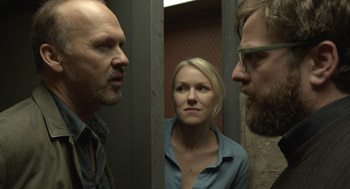 Michael Keaton himself matched Alejandro G. Iñárritu's take on the character beat for beat. He says, 'I think the heart of the character is his contradictions. He feels like a comet one moment and two seconds later, completely deflated. And all that and more would happen within one scene. I have never been in a movie or play where in one to two minutes it went from really funny, to really twisted, back to funny, then really sad, and finally kind of crazy within such a short space of time. The contradictions are what are really cool about it."
Michael Keaton himself matched Alejandro G. Iñárritu's take on the character beat for beat. He says, 'I think the heart of the character is his contradictions. He feels like a comet one moment and two seconds later, completely deflated. And all that and more would happen within one scene. I have never been in a movie or play where in one to two minutes it went from really funny, to really twisted, back to funny, then really sad, and finally kind of crazy within such a short space of time. The contradictions are what are really cool about it." 'In terms of the parallels, I've never related less to a character than Riggan but I did understand him on a lot of levels because he was so visceral and true and heartbreakingly human," Michael Keaton says.
'You know, I think casting is one of the biggest decisions as a director. I tried to cast actors who would not make a caricature of these characters but who would understand their humanity and give them depth even when the circumstances are absurd. I knew that our entire cast consisted of great actors but I also knew they had impeccable awareness and were really capable of being in the moment, to commit to the narrative of the film," Alejandro G. Iñárritu says.
Naomi Watts, who plays Lesley, an actress who makes her Broadway debut in Riggan's play, has an easy rapport with Alejandro G. Iñárritu, having worked with him previously on 21 Grams. She says that because of his exacting visual approach to the material, '… it was the hardest thing I have ever done because it is one unbroken shot, continuous scenes, several actors, room to room, and 15 pages of dialogue. You cannot mess up. Usually, you shoot several different angles in coverage and you get to repeat lines if you didn't like the way you said it. You have a lot of freedom to save or improve yourself. Not in this case. Because of the way he shot it, it's everybody's moment all the time. And not just the actors, by the way. There were so many people standing on the cliff edge with us – props, stunts and especially the camera crew.
It's like a relay race and you don't want to let anyone down because they could be doing their best work. You're constantly aware of the whole team," Naomi Watts says.
Nevertheless, Naomi Watts found the experience to be exhilarating.
'It was like a master class. Although it was excruciating, it was a great challenge and I was thrilled to experience something new. It was much harder on Alejandro. There were a couple times when we were an hour away from wrapping and he still hadn't gotten the shot and then suddenly we'd get into a zone where we were all synchronised. It had to work on the day because he couldn't cut into it or edit it later but at the end of the take, if he liked what he was seeing, there was this massive cheer. We all wanted to please him. It was like winning an Olympic race," Naomi Watts says.
For her character Lesley, the opportunity to appear on Broadway is tantamount to going to the Olympics also and it informs everything she does. Her single-mindedness leads to the casting of the ultimate bad boy artist, Mike Shiner, played by Edward Norton.
'Performing on Broadway is her childhood dream and it's finally here. She's so focused on it; she wants nothing to get in the way. What I love about it is that actors can be very complex people who are absolutely worth poking some fun at from time to time. Lesley in particular is just so desperate for her big break on Broadway. So when they lose one of the actors right before previews, she is worried that it all might fall apart. So at risk to herself, she puts forward the name of her boyfriend who she knows will bring trouble, but she does it anyway," Naomi Watts says.
Edward Norton, known for his work on stage as well as in movies, was impressed at how accurately Birdman captured the New York theater world.
'When I read the script, I found myself wondering how Alejandro and his writing partners got so inside some of the hilarious and poignant nuances of not just the lives of actors but specifically the particular experiences and vicissitudes of New York theater actors. Having come up in the New York theater world early in my career and still being involved in it, I was impressed at how spot on the script was," Edward Norton says.
Edward Norton admits that this world offers a delicious opportunity to investigate and occasionally harpoon the 'idiosyncrasies" of Theater People and Mike Shiner is an entertaining specimen.
'I think any time you dig into the life of actors, inevitably you've got some blend of authentic artistry and a real passion for storytelling – and then you've also got narcissism, ego, self-regard, all of it. The appealing thing to me about Mike Shiner is that he is paradoxically a cad with an enormous ego and is supremely vain, covetous, a little sneaky, but he is also extremely talented. He knows what he is talking about, he is committed to the craft, he works hard, and he is very sensitive. He is able to perceive people's essence through their own kind of protective veils. I feel like Riggan's relationship to him is similar to what the audience's might be," Edward Norton says.
EdwardNorton adds that while Birdman is specific to actors, it was the project's universal themes that intrigued him. 'Alejandro said to me in the beginning that he didn't want this to be just about actors or even artists per se. He wanted it to be about something that anybody would relate to. I think what he was really in interested in was the idea of those moments in life when you feel you've gotten far away from the noble idea that you had of yourself at some earlier place in your life. Alejandro has such a soulful view. It can be a deeply existentially terrifying kind of moment as you approach a certain age and you start thinking about your own mortality and have to confront the idea of being less than you had somehow envisioned you would be. I think that the story hinges on Riggan taking an audacious shot at recovering a sense of himself that he can be proud of – he just happens to be an actor. How he does it, to me, is poignant and often hilarious because of the lengths he is willing to go to achieve it," Edward Norton explains.
Trying to keep all of this together is the play's producer and Riggan's best friend Jake, played by Zach Galifianakis. He has his work cut out for him on every level. Of all the characters, Jake is probably the sanest – which was a welcome change for Zach Galifianakis, who certainly knows his way around crazy.
'I was a big fan of Alejandro's movies. I liked him even before I knew him and when we met for coffee, he told me he wanted me to play something a little bit more real and subtle as opposed to a caricature, which was a refreshing thing for me to try," Zach Galifianakis says.
He comments further on his character: 'Riggan and Jake have been working together for a while. I think they probably had some good days in the past, when Riggan was at the top of his game. And now they are trying to figure out their next movie which means going to Broadway to legitimize their careers a little bit. Jake's a little bit of an archetypal character for me. Jake is a little bit of a hot head and loses it from time to time, which is also fun to play," Zach Galifianakis says.
Emma Stone plays Sam, Riggan's daughter, newly sprung from rehab and working as her father's assistant. Their relationship is strained – his onetime fame as the super hero Birdman meant that he was absent for much of her youth. Hiring her as his aide doesn't do much to improve their situation. Sam has a keen eye and observes her father and the histrionics that come with his play with wry dispassion that is spot on but also a bit of a defense mechanism.
She says: 'Because she is fresh out of rehab, I assume she needs to be watched by a family member. So she makes a huge mistake by working for him. It doesn't help that he can't connect with her at first and has her doing really menial errands. So it doesn't begin well but by the end, she starts to see that they are very similar. Sam is one of the few characters in the movie who isn't an actor, who isn't in the play. That was kind of nice to play, she's on the outside and witnesses all that is happening without being in the tornado on stage with all these crazy people," Emma Stone says.
And while this play has become Riggan's single focus and his bid for artistic relevance, his daughter has a completely different and modern definition/measurement of what it is to matter.
'We find Riggan at a point of no return, in the midst of mounting a career comeback mostly driven by his desire to be relevant. My character Sam teaches him a lot about social media and the new nature of fame, which is something he is willfully ignorant of. The way actors are accessed now is very different than when Riggan was coming up as Birdman, 20 or 30 years prior. He wants to mean something but he also wants to be well-liked and respected as an artist but there is this sort of a modern day keeping up with the Joneses, this desire for mass appeal – and I think everyone can understand and relate to that," Emma Stone says.
Fortunately, she had a supportive guide in Alejandro G. Iñárritu. 'I learned so much. It was so exciting to live and breathe the character for the entire length of the scene. And Alejandro is so tuned in to actors, he knows what is going on your head line by line, sometimes better than you do. There was a day when I knew it just wasn't working for me and suddenly I could feel it kick in and as I did, he clapped and said, -That's IT!' It's amazing. I've never met a director who could do that, he feels what you do," Emma Stone says.
Amy Ryan plays Sylvia, Sam's mother and Riggan's ex-wife, who stops by the theater from time to time to check on them both. 'Sylvia is the one sound, sane, grounding voice in their lives, I think. She provides the voice of reason and represents real love, whereas everyone else confuses adoration for love to measure their self-worth," Amy Ryan says.
Unlike many people who are in and have been in Riggan's life, Sylvia is not an enabler, but, as Amy Ryan points out, a cheerleader. And Riggan doesn't make that an easy job. 'I think the most daunting thing about being a cheerleader for someone is when they don't hear you. Which is what happens between Riggan and Sylvia – he keeps getting in his own way and can't see the truth or beauty that she sees. Even after their divorce, she tries to support him and it's exhausting," Amy Ryan says.
Like the rest of the cast, Amy Ryan had to get used to the very specific visual aesthetic. She literally had to get her bearings and was grateful that it was a team effort. 'The extensive rehearsals helped. It was great to have everyone around and so rare to work on a film where you're with the entire company. We were all in it together," she says.
As Laura, one of the actors in Riggan's play, Andrea Riseborough plays his lover. His apparent ambivalence triggers all sorts of reactions in Laura but unlike Riggan, she is actually pining for real, adult love as opposed to mere adulation. Riseborough got to know Laura intimately during the elaborate rehearsals Iñárritu staged, a process that continued throughout production. As important as the technical aspects of the cinematography were to performance, Alejandro G. Iñárritu paid equal meticulous attention to the nuances of the characters and storylines.
'Alejandro has a temperature gauge for each moment; he made every single section real. One of the most fascinating things about working with him was that before we even started filming, during rehearsals, he made sure I felt a sense of who this person was. I felt I knew Laura innately. And during production, every day I discovered more about her through him. He unfolds a character for you by saying very little, which allows you to find the character too. Sometimes, that for me was an amazing and totally unique experience," Andrea Riseborough says.
Bringing Birdman To Life: The Writing Process
Befitting a story as idiosyncratic and original as Birdman, the writing process itself was unusual and collaborative. It utilized the talents of four scribes, all friends – Alejandro G. Iñárritu, Nicolás Giacobone, Alexander Dinelaris, Jr. and Armando Bo. Iñárritu, Giacobone and Bo had written the screenplay for Alejandro G. Iñárritu's film 'Biutiful," together. Dinelaris is an acclaimed playwright, and Bo directed the feature 'The Last Elvis," which he co-wrote with Nicolas Giacobone. The four pooled their talents and backgrounds to create the story of Birdman - over time and not always in the same place – or even the same country.
'There were several stages where we got together in different locations – New York, Mexico or Los Angeles. Through Skype we were really working for two years. It was a beautiful, fun collaboration, one of the most wonderful writing experiences I have ever had. We were always on the same page but for us the challenge was to find the internal rhythm of the piece without losing the narrative," Alejandro G. Iñárritu says.
Each writer brought a different strength to the process and together their contributions gave way to the cohesive whole script that Nicolas Giacobone calls 'this weird and wonderful creature, Birdman."
'Screenplays often have weird journeys and a collaboration between four guys made it even more complicated but we really became a team and it was an incredibly enjoyable process," Nicolas Giacobone says. 'It started with Alejandro having this idea to do a comedy in one shot. That was the first information he gave us which was quite peculiar and definitely intriguing. It was fascinating, especially in the beginning, because everything about it was new and quite unpredictable. The idea of the one shot was challenging because it was the first time that everything on the page would actually be in the film and we had to always consider that in writing the screenplay. Precision was essential for all of the transitions and how they affected the rhythm of the dialogue and comedic moments," Nicolas Giacobone says.
Alexander Dinelaris' background was particularly key because much of the film takes place behind the scenes at the St. James Theater, where Riggan makes his bold stand to resurrect his career. Enter Alex Dinelaris.
'Having Alex was essential. He's not only playwright but an amazing writer. What was particularly gratifying for me was how we connected personally. We all had a lot of fun writing this," Nicolas Giacobone says.
Alexander Dinelaris says, 'The one-shot movie set us up for rapid-fire dialogue and Alejandro thought that was something I would enjoy and I certainly did. The sort of meta-experience of the continuous shot feels like the way you approach a stage piece. That's what we talked about early on and that was a really nice idea. You always get the quarreling between theater actors and film actors. Film actors say of theater people that everything they do is so big and overdone and theater actors say, Well, you guys don't have to do anything and you get seven, eight, nine, 12 tries at it. It's the perennial fight. In this case, it was sort of a play within a movie within a play because we weren't going to get cutaways and we had to be very diligent about making sure scenes had a beginning, middle and end and yet they were still all connected somehow? It was a challenging, super exciting process."
Alexander Dinelaris continues, 'In this case, we were writing for both stage and film. When you can't cut away, you're hampered as a writer. One of the tenets of writing is get in late and get out early (William Goldman) but you can't really do that with this movie because the camera is always pushing you into the next room. So you are always in early, so somehow you have to make it feel like you are getting in late to the scene. And that's the great challenge. We couldn't write to the cut and that's incredibly difficult and exhilarating because you are forced to search for answers. We planned everything within an inch of its life from the choreography of the camera moves and the actors blocking to the dialogue. The whole movie had to be planned so it could seem like a bunch of people spontaneously riffing and bantering off each other, anchored by Riggan Thompson, who is unraveling from moment one. You find him in this meditative pose and you realize later he is trying to quiet his mind and the last frame of the movie is, as Aristotle would say, -the surprisingly inevitable end'."
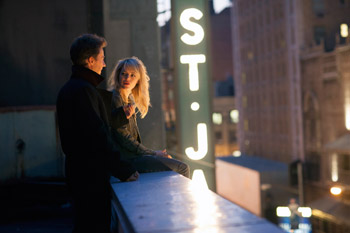 Nicolas Giacobone adds that '…It was intense work but then when he actually went to shoot the movie, Alejandro had everything worked out in detail, including the script, and he could just concentrate on the acting." Although Riggan is an actor and this is set on Broadway I hope that people will see that Riggan is a very universal character and he feels something that we all suffer. We all have this Birdman voice one way or another telling us that we are great, that we know everything, that we are the best and then one hour later, telling us that we are the worst thing in the world, that we are so mediocre and stupid. I think everyone can relate to that on some level. His is a journey of ego and he builds a mountain of ego and when he falls, he does in a very dramatic, tremendous way but it is the only way for him to learn, to get back to the essentials," he concludes.
Nicolas Giacobone adds that '…It was intense work but then when he actually went to shoot the movie, Alejandro had everything worked out in detail, including the script, and he could just concentrate on the acting." Although Riggan is an actor and this is set on Broadway I hope that people will see that Riggan is a very universal character and he feels something that we all suffer. We all have this Birdman voice one way or another telling us that we are great, that we know everything, that we are the best and then one hour later, telling us that we are the worst thing in the world, that we are so mediocre and stupid. I think everyone can relate to that on some level. His is a journey of ego and he builds a mountain of ego and when he falls, he does in a very dramatic, tremendous way but it is the only way for him to learn, to get back to the essentials," he concludes. In Concert With The Camera
Long before the film was shot, the film was conceived, written and meant to be a continuous life experience. 'Since the first page of the script, I knew I wanted it to be live and make the audience experience a real point of view from the main character in a radical way. This represented a completely new approach for me and all the people involved so the challenge started from the script to the last frames of post-production," says Alejandro G. Iñárritu.
The extended, intuitive, unbroken nature of these shots, accomplished via Steadicam and hand-held cameras meant that the lighting was not done with traditional film equipment. The blocking and dialogue were precisely timed with the camera movement. As such, it was less like a movie set and more like the theater in which much of the film takes place.
'We first blocked, rehearsed and designed the shots in an empty set with stand-ins. In comedy, rhythm is king. So through this process, I not only found the internal rhythm of the scenes but the sets and spaces were designed with enormous precision after we all learned from it," explains Alejandro G. Iñárritu.
'Chivo (aka Emmanual Lubezki) was the best partner I could have had. Not only is he a master of light but I think few DPs would have been able to handle the technical requirements of this film. We were not able to light the actors in the traditional way – when you do conventional coverage, you light each angle and have the time to do it. That he was able to accomplish the lighting in this way without compromising the look of the film took incredible skill and craft and I think only Chivo could have done it," Alejandro G. Iñárritu says.
Because the camera work was so specific, Alejandro G. Iñárritu insisted on comprehensive rehearsals with all the actors. 'They really had to understand what I was doing - every movement, every step, every turn of the face was pre-decided and meticulously choreographed. Nothing was improvised, it was a study in timing, with the precision of a clock," Alejandro G. Iñárritu explains.
'It was shot every day as one scene. You shot in continuity. Usually you get five takes here, get 12 takes here, get close-ups, lot of choices to stitch together a performance. There is none of that here. You have no safety net. You have one shot at it. And it all had to come together, and every actor had to be right on it," says Michael Keaton.
'I had a Philippe Petit picture in my office and I sent a copy of it to every actor. I wanted them to remember that we would all be walking on a high wire – dependent upon precision, confidence and a trust in each other. We could fall very easily," says Alejandro G. Iñárritu.
Although the technical aspects of these run-throughs were obviously important, equally vital was the time spent delving into the characters. 'We went through a very deep and interesting process to really observe all the scenes, the meaning and objective of the material, the macro and micro of all the characters, the objectives and motivations as well as the repercussions of their emotions and actions," Alejandro G. Iñárritu explains.
Edward Norton relished the tracking shot approach to filming Birdman and notes that it not only underscores the sometimes weird, twisted and loving bonds between the characters, it is the logical next step in Alejandro G. Iñárritu's film canon. Fittingly, in a movie about a play, Norton also notes that it lent a theatricality to the production as well.
'Alejandro was trying to do something incredibly exciting which was to create literal interconnectedness through the shot. The notion of essentially filming in one take was to me a variation of on a theme that Alejandro has been pursuing which is how do create a wild experience of interconnected moments. For instance, with Babel you've got different worlds interconnected ultimately by threads. In this one you've got relationships and events interrelated by this visually seamless transfer from one moment to the next, to the next, to the next, to the next and I loved it. It puts the baton in an actor's hand in a way you really only get to do in theater. And there is something really potent about that. I think is also does something unconsciously to the energy of the performance. Alejandro likened it to being on a tightrope without a net. It sharpens you up in a way that is different from typical movie shoots," Edward Norton says.
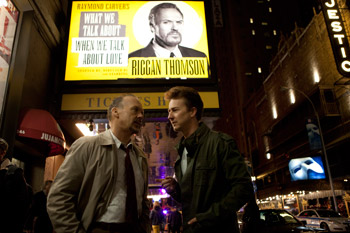 Alejandro G. Iñárritu's uninterrupted takes were a nerve-wracking experience for Emma Stone as well. 'We did this scene where I had just one or two lines but it was very important because it was part of a very long scene between Michael Keaton and Edward Norton. My job was to come in and say something like -Larry's ready for a fitting now' and then take Edward Norton around a corner. That was all I had to do, but Alejandro told me I had to slow down by about 30% or he wouldn't be able to make the scene work. I was like, oh my God. I can't mess up. By take 25, I was just sitting backstage and couldn't even deliver my line. The pressure was immense. It was just like theater, every take is on you. It was like going to an acting gym. Everything is extremely technical but you also need to be present and alive because every moment that you are on camera will be in the film there is no cutting away. There's no, -oh, I screwed that up but they can use a different take,'" Emma Stone says.
Alejandro G. Iñárritu's uninterrupted takes were a nerve-wracking experience for Emma Stone as well. 'We did this scene where I had just one or two lines but it was very important because it was part of a very long scene between Michael Keaton and Edward Norton. My job was to come in and say something like -Larry's ready for a fitting now' and then take Edward Norton around a corner. That was all I had to do, but Alejandro told me I had to slow down by about 30% or he wouldn't be able to make the scene work. I was like, oh my God. I can't mess up. By take 25, I was just sitting backstage and couldn't even deliver my line. The pressure was immense. It was just like theater, every take is on you. It was like going to an acting gym. Everything is extremely technical but you also need to be present and alive because every moment that you are on camera will be in the film there is no cutting away. There's no, -oh, I screwed that up but they can use a different take,'" Emma Stone says.
Zach Galifianakis calls Alejandro G. Iñárritu's visual style a 'seamless narrative" and also sees it as a fittingly bracing acting test in a movie about actors. 'I think it is such an interesting way of telling a story, the camera moving in real time. There is real geography and timing, in terms of hitting your marks, delivering your lines. I didn't think I was capable of it but Alejandro was so easy-going and nice. I found the whole thing to be intriguing – a movie about an actor ends up being a real actor piece for all of us," Zach Galifianakis observes.
Setting The Stage
Birdman shot for 30 days entirely in New York City, Alejandro G. Iñárritu's first movie in Gotham and there were never any other stand-in cities the filmmakers considered.
'The city and Broadway are characters themselves in the film. To make the film feel as authentic as it possibly could, what better place than New York. The great thing is that there is such a talented pool of artists and technicians and actors in New York, just the right balance of stage and movie people that Alejandro wanted," says producer John Lesher.
The filmmakers also elected to shoot the movie largely in the order that the story plays out, unusual for any production but especially ambitious for one photographed in such a specific way with such a short filming schedule.
'Continuity was essential for Alejandro's process as well as exploring Riggan's internal path; it supported the film. Each day Michael did a yeoman's job, setting the proper tone and pacing the transformation of his character - he was truly amazing," says producer Jim Skotchdopole.
The production shot much of the film in the real Broadway theater, the St. James on 44th Street in the heart of Times Square. The St. James has a storied history. Built on the site of the original Sardi's Restaurant, it opened in 1927 and many notable productions have opened there, including 'Native Son," 'Oklahoma," 'The King and I," 'The Pajama Game," 'Beckett" and more recently, 'Gypsy," 'American Idiot," 'Hair" and 'Bullets Over Broadway."
'It's unprecedented for a show to come into a working Broadway house and shoot interior scenes for as long as we did. But the theater was the anchor of everything in the movie," says location manager Joaquin Prange. 'That was the biggest challenge, finding the right theater that could work with our schedule. We culled it down to about half a dozen and Alejandro – and everyone – responded to its history and look and feel. While it is majestic, it has a lot of character, it's rough around the edges and I think that fits with what he is going for Riggan. He is in a house that is not quite the premiere stage on Broadway; it's on a side street, not Broadway itself. And while there are successful shows all around him, this is a house that has had a lot of turnover and you feel that this is a place where the play could actually take place."
'The Broadway world has a schedule, they rehearse every day from 8 am to midnight – whereas our call time depended on what we had to shoot and when we finished the day prior. So little things like that threw the theater guys for a loop but they rolled with it and were great. It was a real learning process for all of us" Joaquin Prange says. Birdman of course utilized the St. James' stage where at one point, the actors performed the final scene of the play 'What We Talk About When We Talk About Love" in front of a live audience of extras. The theater lobby and exterior were also set pieces in the film.
'I know it was important for Alejandro to capture the spirit of Times Square and Broadway itself, the activity on the street, the people, the lights, the traffic, just the density of everything, and certainly 44th Street is great because it's right on the precipice of Times Square. We felt that energy just a block away," Joaquin Prange explains.
Production designer Kevin Thompson was tasked with marrying the St. James with a recreated backstage and dressing room set that his team built at Kaufman Astoria Studios. 'My first conversation with Alejandro was about the physical world of the theater on stage and behind it. He was very interested in the two emerging and overlapping. I thought it would be incredibly challenging to have these two worlds meet. And the idea of filming in a real Broadway theater, designing sets for that and for the play plus the backstage dressing rooms and labyrinth of corridors was really intriguing," Kevin Thompson explains.
Those rehearsals became blueprints for the sets and ultimately morphed throughout production, not just to accommodate camera moves but also to reflect Riggan's mental condition. 'The notes that came out of those rehearsals defined the actual size and shape of the set. Like when we would go downstairs, when we go upstairs, when we would go on a long walk through a corridor, when we would stop, where they would stop, that had to be a special kind of transition period and the sets had to accommodate all of that. The rehearsals informed the length of the corridors between the dressing rooms, for instance, how far from Michael Keaton's dressing room is to the stage entrance. It had to be a certain length and it had to turn a number of times so we would change the backstage configuration to adapt to the scenes so it would seem as though it was done without any cuts or edits. And then the corridor to Michael Keaton's dressing room would shrink as the movie went on – we made it narrower and dropped the ceiling – to make it more about the state of mind that he was in. The set was also made so we could fly out a little section here or there to make the camerawork possible. Chivo could back into a wall all of a sudden or have a piece of it disappear, which you can't do on location," Kevin Thompson says.
Kevin Thompson also discusses the lighting and color palette for the film. 'Alejandro likes introducing color in a curated and controlled way. The way it was accomplished in my department was through Chivo's lighting. We used practical fixtures throughout because we had to be able to move the camera freely without movie lighting getting into or in the way of the shot. So we'd get a lot of different color temperatures of light, from cool tungsten to a warmer incandescent. It was lit for film, not theater – Broadway productions have a more heightened version of blue and red lights but ours were more like cool and warm colors crashing into each other and layering on top of each other. Chivo lit the stage in such a unique way, with a big LED in the ceiling and being able to change the color and move the light around as we shot," Kevin Thompson says.
Costume designer Albert Wolsky, with whom Kevin Thompson closely collaborated, has vast experience in both movies and theater. He has won two Oscars® for Best Costume Design ('Bugsy" and 'All That Jazz") and has been nominated five times and earned a Tony® Award nomination for his work on the 2013 production of 'The Heiress." Throughout his career, he has moved easily between stage and film. The push-pull of Broadway and Hollywood is an underlying theme in the movie and manifests in Albert Wolsky's costumes because of his background, no one understands that tension better than Albert Wolsky. That uneasy alliance played out mostly in the characters' 'backstage" clothing. Says Albert Wolsky: 'For the backstage rehearsals, I was trying to capture a certain kind of casualness. Nobody dresses up and then there was also the feeling that this informal, laid-back style came from California. In the back of my mind, I was always balancing the theater and Hollywood. The difference is subtle between the New York version of casual and that of California but it's there."
Albert Wolsky, of course, had to design the costumes the characters wore in the actual play, which was also a balancing act. He had to create wardrobe that could plausibly work on Broadway but was also cinematic and stood out from their everyday clothing.
'Even though Carver wrote the story in the early 80s, I thought it was better to push the wardrobe for the play a little further back. I thought the 50s would be good because the 70s and 80s are too close to what we wear today. And then I had to consider the materials we would use because we were still shooting a movie. The camera sees differently than the actual eye does, it sees in two dimensions whereas your eye does not, so the texture and depth of some fabrics are more evident on stage than they are on film. I learned that when I started going back and forth between theater and film. In features, details that work for a close-up, for instance, do not work for the tenth row in the theater. In terms of color, I could push it a little bit. Chivo doesn't like primary colors so I was conscious of using deeper hues for the play than I would for their backstage wardrobe," Albert Wolsky says.
Albert Wolsky believes that his work on All That Jazz, a seminal movie that also examines the world of Broadway and Hollywood and ambivalence between the two, as well as the nature of art and commerce, intrigued Iñárritu. 'The first thing we talked about was All That Jazz. Directors seem to be very influenced by that movie. For me, I work from the material but your own experience of course becomes an influence and after a while it is hard to tell where something comes from because it is part of your DNA," Albert Wolsky says.
Albert Wolsky did not design one specific piece of wardrobe – the actual Birdman suit. That fell to Mike Elizalde to help bring Birdman to life. Filmmaker Guillermo del Toro recommended Mike Elizalde to Alejandro G. Iñárritu. 'I was thrilled because I've been a huge fan of Alejandro for years. He's a brilliant filmmaker, and it's a rare opportunity for someone who works in creature effects and prosthetics that get to work with somebody that makes the films that Alejandro makes. It became clear to me very quickly that he knew exactly what he wanted, which always makes our job easier," Mike Elizalde says.
The look and feel of Birdman began with Mike Elizalde's first read of the script and it was obvious that Birdman would be like no other entity Mike Elizalde had ever created.
'He is Riggan's alter ego and I felt how important this character really was and what a deep part of Riggan's consciousness he was. Birdman elevated him to fame and maybe cursed him to be pigeonholed as this superhero. So it was multilayered for us. Typically when we design a creature, we know exactly what it is. It's a ghoul. It's a werewolf. Whatever it is, but Birdman was much more than that. He is a psychological symbol of this man's past, the thing that grounds him and also potentially can destroy him, maybe DID destroy him on some level. It was a cool challenge," Mike Elizalde explains.
Mike Elizalde explains that the design was a collaborative effort between Alejandro G. Iñárritu, Michael Keaton and Mike Elizalde and his team.
'Alejandro intentionally wanted to preserve what was familiar to us about Michael Keaton playing Batman. So parts of his face that are exposed are in the same sort of shape and proximity to Batman. He also showed us pictures of the back of a vulture - that had these beautiful shoulders and lots of rough, iridescent blue feathers. We came up with a basic head to toe look – some areas more textured than others, a darker color scheme to reflect his psychology, elements of grandiosity like his big, gold belt buckle, to underscore his ego. Like Birdman was this grand kind of character who was the antithesis of what the actor Riggan became. We also established a hawk-like face, impressive wings and a sleek looking, modern silhouette that also had an element of camp," Mike Elizalde explains.
Mike Elizalde and his team constructed the suit and the molds with Michael Keaton using special proprietary fabrics. This bespoke Birdman suit fit him perfectly and was also light enough to allow him to act. He gave us a huge compliment when he told us, -I can move in this one.' So on a practical level I think we delivered something that he was able to perform in more freely and still retain some of the aesthetic of his character," Mike Elizalde says.
Editors Stephen Mirrione and Douglas Crise were tasked with piecing all these distinctive elements together without mangling the elegant, seamless lines of the cinematography. Both have worked together with Iñárritu on previous films and Mirrione both understood how crucial editing is for this movie.
'During production, Alejandro said to me many times, -I have to think of everything now. On every other movie, I could fix it later in the editing room …," Douglas Crise says.
''But this time, I know I have to get it right,'" adds Stephen Mirrione. 'He was constantly worried about that. There is no question that the reason they were able to pull it off is because the actors came in incredibly prepared."
Like the actors and really everyone on the crew, the thorough rehearsals became the basis of their edit.
'Before cameras even rolled, we had an assembly made up of the rehearsal footage and some of the table read so together with Alejandro we could begin to gauge what the film would look and sound like, where a conversation was redundant, where the moves would be. So we were able to get started very early on," Stephen Mirrione says.
The editors also found they had an able partner in the visual effects team, who organically contributed to the unique cuts in Birdman. Happy, creative additions happened as a result of this collaboration.
As with every film, the editors used their ears as much as their eyes but because of the precision of the shots, they had to be extremely vigilant in their aural choices. While the seamless nature of Birdman may look and sound effortlessly fluid, the actual assembly, like everything else in the film, was painstakingly crafted. 'The big difference with this film was that we didn't have the conventional places where one scene started and another ended. Every scene walks into the next one. Alejandro described it as going down a hill and not stopping. There wasn't really a transition, the characters just keep moving on," Douglas Crise says.
'I think we really anticipated a lot of the potential pitfalls and really prepared, but what we didn't plan on were all the speed changes," Stephen Mirrione adds. 'At certain points, when the scene was not popping for us, if the tempo was a little off, we could actually dial up the pace or slow it down as need be without it being perceptible to the audience and that made a big difference."
As it turns out, Stephen Mirrione and Douglas Crise applied syncopation and pace in another way as well - they worked closely with Alejandro G. Iñárritu and sound designer Martín Hernández on an insistent percussive refrain that, like Birdman, accompanied Riggan wherever he went. The process began during production when Douglas Crise huddled with Alejandro G. Iñárritu to provide a first pass for the editors.
'By editing you can alter rhythm and pace. Not having that tool in a comedy can be extremely challenging. So I thought the drums as the main score would provide the film not only a good vibe but the possibility in helping me find the beat it needed. The Mexican drummer Antonio Sanchez, one of the best in the world, and I rented a studio one week before I started shooting and he recorded and improvised 60 tracks based on some objectives or emotions the film needed. That helped me enormously and sometimes I even used it on the stage for the actors to understand the rhythm of the scene. Rhythm is everything in cinema," says Alejandro G. Iñárritu.
'Alejandro had all these drum recordings and he told me to pick six of my favorites. We cut those together so that he could have a track that the drummer could mimic when they shot that scene. He had the idea for the soundtrack from the very beginning and we had those samples cut in from the start too," Douglas Crise says.
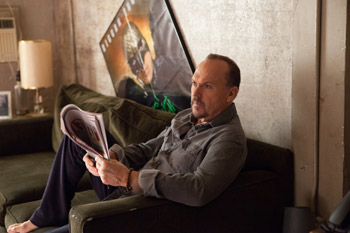 'And then Martín took it to another level. Once there was an first pass at the movie, with a lot of those drum tracks laid in as an outline, he spent a lot of time working with Alejandro, to strip layers away, add some in, trying a lot of different beats. Obviously, in every movie, music will have an impact on point of view and mood and tone. But with this I think it was especially important because the rhythm is so tied to the camera and you can't make those kinds of cadence adjustments with as much flexibility as you can with cuts. We had to lean on the music a little more than normal at times, to push back or pull forward," Stephen Mirrione says.
'And then Martín took it to another level. Once there was an first pass at the movie, with a lot of those drum tracks laid in as an outline, he spent a lot of time working with Alejandro, to strip layers away, add some in, trying a lot of different beats. Obviously, in every movie, music will have an impact on point of view and mood and tone. But with this I think it was especially important because the rhythm is so tied to the camera and you can't make those kinds of cadence adjustments with as much flexibility as you can with cuts. We had to lean on the music a little more than normal at times, to push back or pull forward," Stephen Mirrione says.
The rhythm of the drums tied to the flow of the camera tethered to Riggan's journey towards self-discovery and artistic reflection were not mere gimmicks but rather indicators of the movie's heart.
'I think it's a kind of magic, this narrative. By a continuous shot my hope was really to get audiences in the point of view of the character. To really live through Riggan and his mind, to walk in his shoes. A continuous flow of emotion and like Riggan, unable to escape it. To understand his desperation as he walks by those walls and through corridors. Because in the end, our life is just one continuous shot. We wake up in the morning and then we are all day with a Steadicam of sorts floating with us, we don't escape, we don't cut to another reality. We are trapped in our own reality. That's the way we experience life so I wanted to experience Riggan's world that way too. It's not just a visual. I wanted to have an emotional narrative with dramatic tension and purpose. I hope it worked," Alejandro G. Iñárritu sums up.
'Now look, your grace," said Sancho, 'what you see over there aren't giants, but windmills, and what seems to be arms are just their sails, that go around in the wind and turn the millstone."
'Obviously," replied Don Quixote, 'you don't know much about adventure."
– Don Quixote, by Miguel de Cervantes
Birdman
Release Date: January 15th, 2015
Have You Seen This?
MORE


